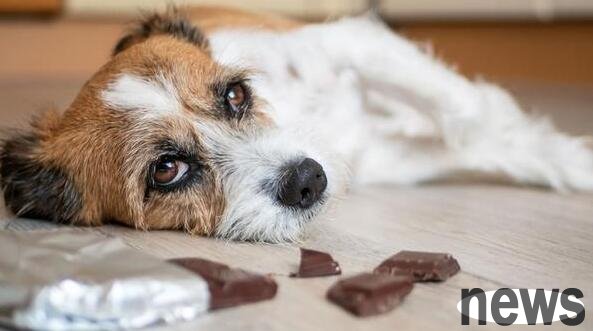Why can't you give your dog chocolate? Answer: Cocoamin Cocoamin is a naturally occurring biological stimulant in cocoa beans. It has diuretic, myocardial excitation, vasodilation and other effects in medical applications, and cocoamin is theref...
Why can't you give your dog chocolate?
Answer: Cocoamin
Cocoamin is a naturally occurring biological stimulant in cocoa beans. It has diuretic, myocardial excitation, vasodilation and other effects in medical applications, and cocoamin is therefore endangering the life of dogs.
When a dog consumes less cocoa alkali, it generally does not have too many problems, but when the intake exceeds the range that its own metabolism can withstand, symptoms of poisoning will occur. In the early stages of poisoning, dogs may experience symptoms of vomiting, diarrhea, or hyperpsychiatric symptoms, which usually last for several hours. When the toxicity spreads, the dog's heart rate will increase significantly, and it will also show polyuria, irritability, fidgeting, shortness of breath, and muscle twitching. When the situation continues to worsen, it will cause the dog to lose control, epilepsy, coma, and even death.
So, please do not give it chocolate for your dog!

If you must give it food, please do not overfeed, unless you want to kill it.
But this amount is really difficult to grasp, because different breeds of dogs, dogs of different weights, and dogs of different ages have different tolerances to cocoa alkali, and it is difficult to give an absolutely safe intake standard. In other words, even if the same dog has a constant weight, eating a piece of chocolate when he is young does not mean that he will not become a Buddha after eating the same amount of chocolate when he is old.
If you consider the large and complex family of chocolates, the situation will be even more complicated. The content of cocoa alkali in different varieties varies greatly, and the risk to dogs is naturally different. So it is basically impossible to come up with a safe chocolate feeding standard.
So if you still insist on feeding chocolate to your dog, the only reliable advice I can give you is: which chocolate is less dangerous to feed.
The relatively safe chocolate for dogs is white chocolate because its main ingredients are dairy and sugars, and it does not contain cocoa powder. Therefore, the content of cocoa alkali is the lowest among all kinds of chocolates, and white chocolate contains about 1 mg of cocoa alkali per ounce (1 ounce = 28.35 grams). On the contrary, the essential medicine for killing dogs and killing dogs when traveling at home is the so-called pure chocolate, including sweet-free chocolate, bitter chocolate, etc. This chocolate has no additives. It is basically made of cocoa beans, and the content of cocoa alkali per ounce is as high as 450 mg.
Here are the cocoamin content of several other chocolates: hot chocolate (12 mg per ounce) milk chocolate (60 mg per ounce) semisweet chocolate (260 mg per ounce).
Finally, regardless of the age and breed of the dog, the feeding warning standards for several chocolates are as follows: White chocolate: A maximum intake of 200 ounces per pound of body weight, and a 20-pound (about 9 kg) dog can eat up to 250 pounds (about 113.4 kg). (It's really a lot... I guess I'll be able to die before I'm poisoning.)
Milk Chocolate: You can eat up to 1 ounce per pound of body weight, and a 20-pound dog can only eat up to 1 pound. Common chocolate varieties contain about 2 to 3 ounces of milk chocolate per piece, so it is safer for a 20-pound dog to eat up to 4 to 6 pieces at a time. Semisser chocolate is referenced by this standard.
Sweet Cocoa: You can eat up to 0.3 ounces per pound of body weight, and a 20-pound dog can eat up to 1/6 pound.
Pure Chocolate: You can eat up to 0.1 ounces per pound of body weight, and a 20-pound dog can eat up to 2 ounces.
How to raise dogs:
1. Give the dog a lot of water. Give the dog cold water suitable for drinking at any time. Change the water frequently. The average consumption of water is at least 60 ml per kilogram of body weight per day. The water consumes more water for puppies, breastfeeding female dogs, working dogs or hot climates.
2. Gradually change the food. The diet of dogs should gradually change and should be transitioned to one week, so that the animal's taste, digestion and metabolism can adapt, and the dog's intestinal tiny substances can adapt to eating divine foods more than the human intestinal tiny substances, so they can restore their function to digest new foods.
3. The greatest happiness of regular feeding of dogs is to eat the same food from the same plate every day at the same time and in the same place. This will be very good for dogs' health.
The time for dogs to eat must be basically fixed, and they cannot eat one after another or one after another. Timing can develop a dog's regular conditioned reflex, secrete gastric juice, increase appetite, and promote digestion and absorption. It is generally better to feed once in the morning and evening. The amount of food in a dog should be relatively stable, and the variety can be renovated, but the quantity cannot be changed. One more meal, one less meal: the consequence of being full and one hungry meal must be overeating, which is harmful to the health of the dog.
4. Control the amount of food
The amount of food per serving should depend on the energy required by the animal and the calories contained in the food every day. The amount of food per serving should be recalculated frequently to avoid obesity, and should also be adjusted as the dog's weight changes.
5. It is important to choose food carefully
. First of all, nutritional balance should be taken into account. There are three criteria for choosing suitable foods for dogs: age (puppy, adult, middle-aged or elderly dog), level of physical activity or physiological activity (active dog, sporty dog and breeding dog), and size (small, medium or large).

6. Reasonable feeding
is as important as the ingredients in the food. Therefore, when feeding commercial food, merchant instructions must be strictly followed.
When feeding homemade food, you should eliminate some "taken of course" ideas, such as "I like to eat what I like", "My dog can eat anything", or "My dog only loves to eat fruit", etc. These ideas often kill your dog (such as giving your dog chocolate or onion, etc.).